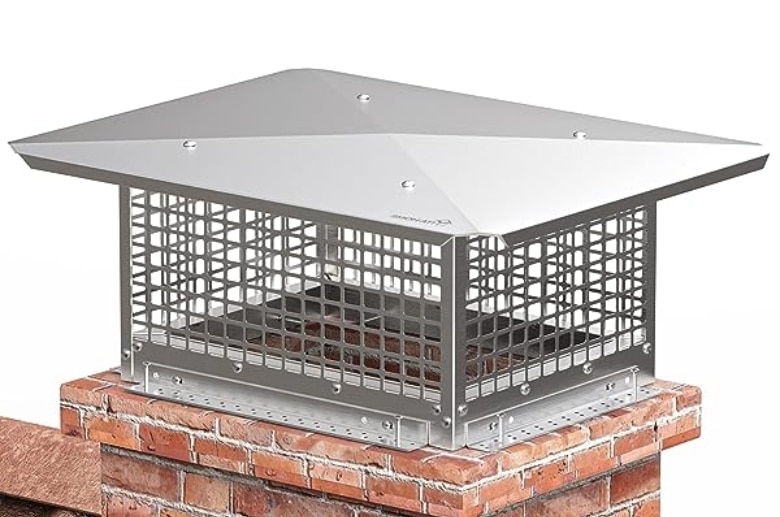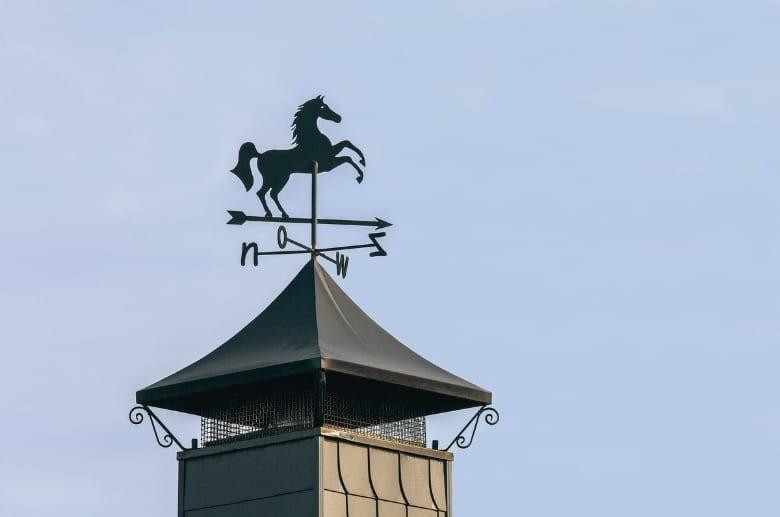When it comes to chimney maintenance, understanding what is the difference between a chase cover and chimney cap is crucial. While both play pivotal roles in protecting your chimney, they have distinct purposes.
The chase cover acts as a shield for a prefabricated chimney top, whereas the chimney cap safeguards the chimney flue itself, preventing sparks from coming out of your chimney and keeping animals from making nests in it.
To avoid confusing the components, let’s discuss their primary functions.
What Is a Chimney Chase Cover

A chimney chase cover, also known as a top pan, top flashing, or chase pan, is used for fireplaces built in a factory. It’s like a metal lid that goes over the top of your chimney’s cover. It has the same function as a chimney crown.
Imagine a really big shoebox lid that covers the whole top of the chimney and comes down a bit on the sides. Its main job is to stop water from getting into the chimney.
The crown seals and covers the top of the chimney around the edge of the top, preventing precipitation from entering the chimney and causing damage to the chimney liner, flue, and other parts of the chimney system.
Here are some of the benefits of using a chimney cover.
- Moisture protection: One of the primary benefits of a chimney cover is that it prevents water from getting into the chimney. Rainwater can cause damage to the chimney liner, flue, and other parts of the chimney system.
- Prevention of animal invasion: Chimney covers can also prevent animals such as birds, squirrels, and raccoons from entering and nesting inside the chimney. This can help prevent blockages.
- Blocking of downdrafts: A chimney cover can help prevent downdrafts, which occur when the wind blows down the chimney and causes smoke and other byproducts to enter the home. A chimney cover can also help prevent debris from entering the chimney.
- Prevention of sparks and embers: Chimney covers can help prevent sparks and embers from escaping the chimney and potentially causing a fire. This is especially important for homes in dry or windy areas.
- Energy efficiency: When a chimney cover is installed, it can help prevent blasts of cold air from entering the home through the chimney. This can help make the home more energy-efficient and reduce heating costs.
There are different materials for chimney chase covers:

- Aluminum: It’s a tough material resistant to rust and damage, almost as good as stainless steel.
- Stainless Steel: This type is strong, durable, and is tough to damage. It’s good at resisting rust.
- Copper: Copper is a great option because it lasts long, looks nice, and doesn’t get damaged easily. It’s also good at resisting rust.
It is important to pick a chase cover that fits your chimney well and is made from the right material.
Picking the right chimney chase cover is easy if you follow these steps:
Step 1. Measure your chimney chase’s size – how long, wide, and tall it is.
Step 2. Think about the cover’s material. Stainless steel or copper are strong choices that don’t easily wear out.
Step 3. Choose a design. Some have holes for air, and some don’t. Think about where you live and what you need.
Step 4. Pick a strong, well-made cover to protect your chimney for many years.
Step 5. Hire a professional to install it. They know how to do it right.
Step 6. Ask about maintenance and warranty – a good cover doesn’t need much care and should come with a warranty.
If you need help choosing the right cover, talking to a professional who knows about chimneys is a good idea.
——
Do You Need to Hire Chimney & Fireplace Expert?
Get free quotes from qualified experts near you. No commitment required!
——
What is a Chimney Cap?

Chimney caps are often the unsung heroes of chimney protection. Whether you have a masonry chimney or a prefabricated fireplace, chimney caps play a vital role in safeguarding your chimney and the interior of your home.
Chimney caps do some important jobs:
- Keeping Water Out: Chimney caps stop rainwater from getting inside your chimney and causing problems. Alongside the cap, a chimney rain pan can also be an essential addition. This component is designed to collect and divert water away from the chimney, further preventing potential damage. Water can harm the inside and outside of the chimney. It can even damage the parts made of metal or clay, which means expensive fixes.
- No Debris Allowed: Caps prevent things like leaves, small branches, and birds from entering the chimney. This helps stop blockages and reduces the chance of fires.
- Stopping Sparks: According to the Federal Emergency Management Agency, clean chimneys don’t catch fire. If you have a fireplace that burns wood, some chimney caps have screens that act like guards. They catch the hot sparks that could fly out and start a fire on your roof.
- Fewer Fixes Needed: Caps protect the very top of the chimney, called the crown. This keeps it safe from dampness. When the crown is dry, it doesn’t break as easily, and you won’t need to fix it as much.
- Looks Nice, Too: You can pick chimney caps that look good on your house. They come in different styles and materials, so you can choose the one that matches your home’s look.
You can choose from different kinds of chimney caps, each made to solve certain problems. Here are the types of chimney caps:

- Regular chimney cap: This one is the most common. It’s usually made of stainless steel, copper, or galvanized steel. It’s put on top of the chimney’s tile and screwed in. It has screens to keep animals out and to catch big sparks from the fire. This cap also helps the wind push smoke up the chimney.
- Top-mount chimney cap: This type stops sparks from getting out and causing a fire. It’s usually made of stainless steel or copper.
- Multi-flue cap: Multi-flue caps are useful if a house has more than one fireplace or stove. Instead of having separate caps for each opening, this one covers them all. It keeps each flue and the chimney’s top safe. They come with screens for wood fires and nice designs.
- Electric chimney cap: These caps make chimneys work better. They have fans or motors that help the air move and stop drafts. They’re often custom-made and need experts to install them.
- Draft-increasing chimney cap: These caps are for chimneys in windy places. They make the wind go around the top instead of going inside. They can be made from stainless steel, copper, or galvanized steel.
When picking a chimney cap, think about what it’s made of, how strong it is, how it looks, and what you need. You can use stainless steel, copper, aluminum, or galvanized steel.
With the same steps above as choosing a chimney cover, you’ll find a chimney cap that will last you for years.
Talking to a professional or a chimney expert can help you decide which cap is best for your chimney. They can ensure that it fits your home’s design, give you a warranty, and install it properly so it won’t easily come off.
——
Do You Need to Hire Chimney & Fireplace Expert?
Get free quotes from qualified experts near you. No commitment required!
——
What Is the Difference Between a Chase Cover and Chimney Cap?
The key distinction between a chimney cap and a cover is their placement and purpose. A chimney cap is placed directly on the chimney flue’s top, while a chimney cover covers the entire chimney chase.
Chimney caps prevent things like dirt, animals, and water from entering the chimney flue, while chimney covers shield the entire chimney system from moisture and debris.
Here’s a table showing their key differences.
| Feature | Chimney Cap | Chimney Chase Cover |
| Primary Function | Prevents debris, animals, and rainwater from entering the chimney | Protects the entire chimney chase from water, debris, and animals |
| Material | Typically metal (stainless steel, copper, galvanized steel) | Usually metal (galvanized steel, aluminum, stainless steel) or concrete |
| Installation | Fits directly onto the chimney flue opening | Covers the entire chimney chase structure, custom-fitted and installed |
| Design | Covers only the flue opening with mesh sides for ventilation | Covers the entire top of the chimney chase and can include mesh sides |
| Durability | Durable against weather and debris, relatively long lifespan | Durable against weather but can show signs of rust over time |
| Maintenance | Requires occasional cleaning to prevent debris accumulation | Requires regular cleaning to prevent water pooling and debris accumulation |
| Signs of Problems | Obstruction, lack of draft, nesting animals | Rust, water leakage, debris buildup in chase area |
| Aesthetic Appeal | Simple and functional design doesn’t affect the chimney’s appearance | Can be less visually appealing due to its coverage of the chase structure |
| Cost | Generally lower cost due to smaller size and simpler design | Can be higher cost due to larger size, custom fitting, and coverage |
It’s important to note that chimney caps and chase covers serve different purposes and are suited for different types of chimneys. The choice between the two depends on your specific chimney structure and needs.
Conclusion
Chimneys are functional components of our homes and architectural features that deserve attention and care. Chimney caps and covers contribute to your chimney system’s longevity, efficiency, and aesthetics.
These two components work together to maintain your chimney.
Whether you’re worried about water, want better airflow, or just want your chimney to look nice, caps and covers are like superheroes for your home. They make sure your chimney stays in good shape.
So, if you’re considering a new fireplace or chimney, consider the various options available and consult with professionals to ensure a safe and enjoyable experience.






